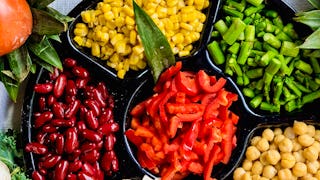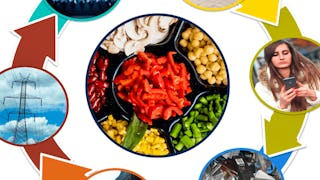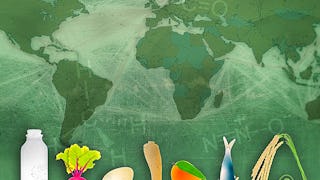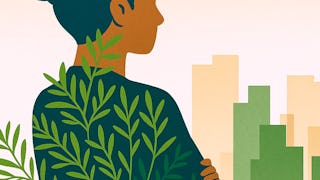This course is an introductory and foundational course on sustainable consumption and health. In the first part of this course, we briefly review definitions of sustainability and the relationship between the three dimensions of sustainability and the UN-Environment Sustainable Environment Goals (SDGs), target and indicators. We then look at frameworks, indicators and footprint requirements to adequately measure sustainability, offering the opportunity to the participants to assess their own carbon and environmental footprint and make recommendation on how to reduce it. We then address the theme of sustainable consumption, looking at our main domains of consumption and at the key conditions to reach sustainable consumption and avoid rebounds effects that tend to reduce the benefits of increased product efficiency. We finally look at "what is good enough" for a given product or activity, in relationship with absolute sustainability and planetary boundaries.


您将学到什么
Analyze health impacts of global trade and of major risk factors
Identify goals and steps for achieving sustainable consumption
您将获得的技能
要了解的详细信息
了解顶级公司的员工如何掌握热门技能

积累特定领域的专业知识
- 向行业专家学习新概念
- 获得对主题或工具的基础理解
- 通过实践项目培养工作相关技能
- 获得可共享的职业证书

该课程共有3个模块
This course is an introductory and foundational course on sustainable consumption and health. In the first part of this course, we briefly review definitions of sustainability and the relationship between the three dimensions of sustainability and the UN-Environment Sustainable Environment Goals (SDGs), target and indicators. We then look at frameworks, indicators and footprint requirements to adequately measure sustainability, offering the opportunity to the participants to assess their own carbon and environmental footprint and make recommendation on how to reduce it. We then address the theme of sustainable consumption, looking at our main domains of consumption and at the key conditions to reach sustainable consumption and avoid rebounds effects that tend to reduce the benefits of increased product efficiency. We finally look at "what is good enough" for a given product or activity, in relationship with absolute sustainability and planetary boundaries. In the second part focusing on health, we will first identify the main factors affecting health, define DALYs (disability-adjusted life years) as a key metric to measure health burden, and use the rich information made available by the Global Burden of Disease (GBD). We will then use the GBD visualization tool to quantify and compare the respective burdens associated with 70 risks factors and numerous disease causes, in every country of the world and even at the state level for the US. We finally analyze the health impact associated with global trade, evaluating the fraction of the health impacts due to fine particulate in Asia, that are induced by Western consumption.
涵盖的内容
7个视频6篇阅读材料4个作业3个讨论话题
This section focuses looks at the key conditions for sustainable consumption providing an overview of the impacts generated by consumers and by the participants themselves. After establishing our personal carbon footprint, we first relate impacts and costs and identify the critical conditions towards sustainable consumption accounting for rebounds effects. We then discuss how far we have been able to decouple environmental from GDP in different regions of the world. We finally discuss what is good enough and what the product specific targets can be to meet sustainable consumption objectives, not to exceed planetary boundaries.
涵盖的内容
8个视频4篇阅读材料3个作业1个讨论话题
We will now look at the dietary impacts of multiple foods to then analyze trade-offs and targeted change that can bring substantial health and environmental benefits with less than 10% caloric change. We finally address the health and sustainable performances of various diets, looking at disparities between gender, races and diets. Then, equipped with the knowledge and skills you developed throughout our course, you will conclude with two final exercises. First, you will develop a 6-point action plan to feed our planet in a healthy and sustainable way as part of a peer-reviewed assignment. Next,
涵盖的内容
6个视频6篇阅读材料6个作业1次同伴评审2个讨论话题
获得职业证书
将此证书添加到您的 LinkedIn 个人资料、简历或履历中。在社交媒体和绩效考核中分享。
位教师

从 Public Health 浏览更多内容
 状态:免费试用
状态:免费试用University of Michigan
 状态:免费试用
状态:免费试用University of Michigan
 状态:预览
状态:预览Johns Hopkins University
 状态:免费
状态:免费Lund University
人们为什么选择 Coursera 来帮助自己实现职业发展




学生评论
18 条评论
- 5 stars
83.33%
- 4 stars
16.66%
- 3 stars
0%
- 2 stars
0%
- 1 star
0%
显示 3/18 个
已于 May 18, 2025审阅
The course was detailed and beneficial, but the assignments were challenging.
常见问题
To access the course materials, assignments and to earn a Certificate, you will need to purchase the Certificate experience when you enroll in a course. You can try a Free Trial instead, or apply for Financial Aid. The course may offer 'Full Course, No Certificate' instead. This option lets you see all course materials, submit required assessments, and get a final grade. This also means that you will not be able to purchase a Certificate experience.
When you enroll in the course, you get access to all of the courses in the Specialization, and you earn a certificate when you complete the work. Your electronic Certificate will be added to your Accomplishments page - from there, you can print your Certificate or add it to your LinkedIn profile.
Yes. In select learning programs, you can apply for financial aid or a scholarship if you can’t afford the enrollment fee. If fin aid or scholarship is available for your learning program selection, you’ll find a link to apply on the description page.
更多问题
提供助学金,
¹ 本课程的部分作业采用 AI 评分。对于这些作业,将根据 Coursera 隐私声明使用您的数据。




